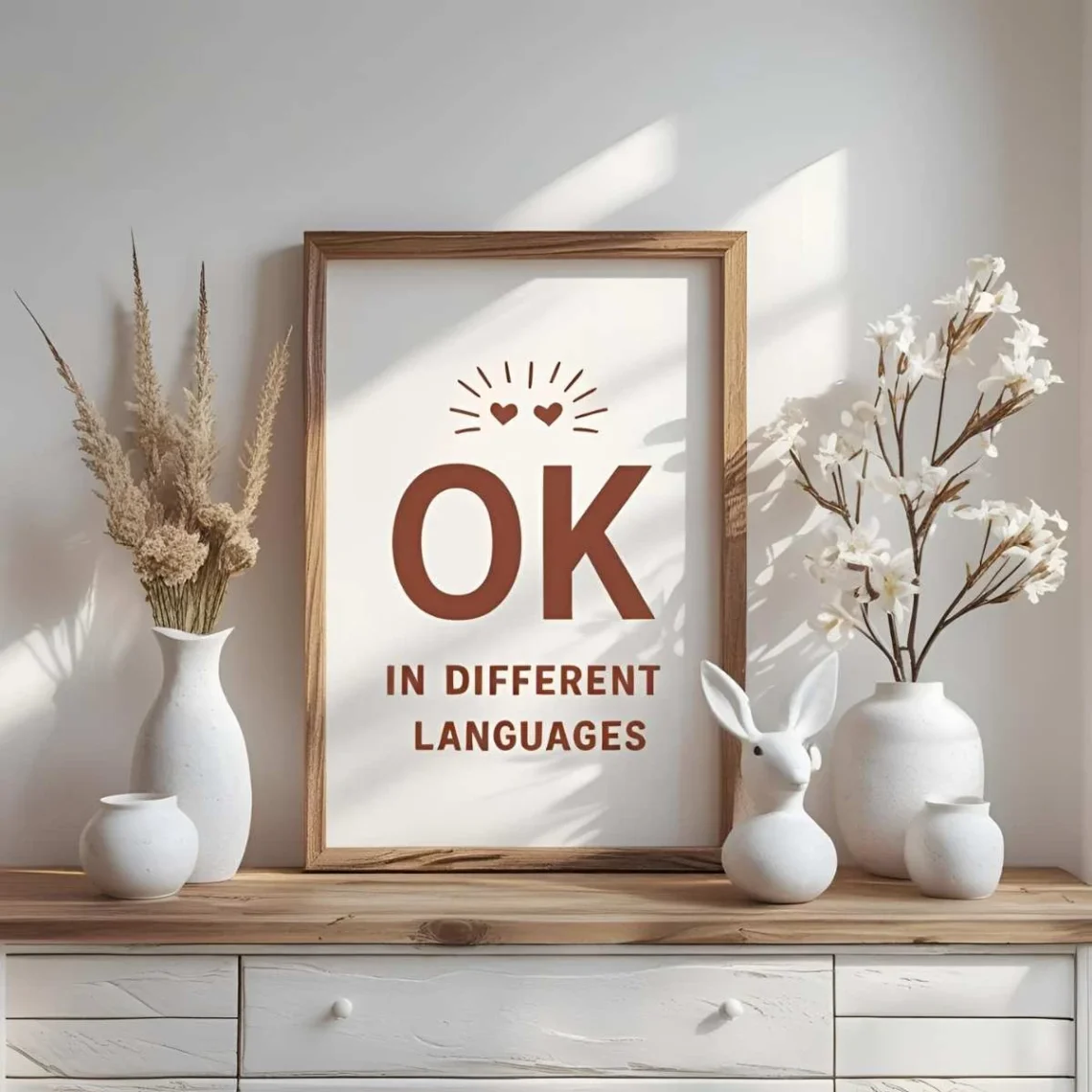Imagine sitting in a lively café in Istanbul, nodding along as a friend says “tamam” to confirm a plan. That simple word, “ok,” carries a universal spark of agreement, yet it transforms across languages and cultures.
Whether it’s a quick “vale” in a Madrid market or a cheerful “oke” in a Jakarta street, the term for “ok” reflects a shared human need to affirm and connect, shaped by each culture’s unique flavor.
Let’s dive into a global journey to explore how people express “ok” in different languages and what these words reveal about their societies.
Reference Table: “Ok” in Different Languages
| Language | Word/Phrase | Cultural/Linguistic Insight |
|---|---|---|
| French | D’accord | Means “in agreement,” used formally and casually. |
| Spanish | Vale | A versatile term for “ok” or “alright,” common in Spain. |
| Italian | Va bene | Literally “it goes well,” implying approval or satisfaction. |
| German | Okay | Borrowed from English, widely used in casual settings. |
| Mandarin | Hǎo (好) | Means “good,” used as a concise agreement. |
| Hindi | Theek hai | Translates to “it’s fine,” reflecting acceptance. |
| Japanese | Daijōbu (大丈夫) | Means “all right” or “no problem,” used reassuringly. |
| Korean | Gwaenchana (괜찮아) | Means “it’s alright,” often used to reassure or agree. |
| Arabic | Tamam (تمام) | Means “complete” or “perfect,” used across 20+ countries. |
| Swahili | Sawa | Means “equal” or “fine,” widely used in East Africa. |
| Zulu | Kulungile | Means “it’s alright,” a warm affirmation in South Africa. |
| Yoruba | O da | Means “it’s good,” reflecting positivity in Nigeria. |
| Maori | Pai | Means “good,” a simple agreement in New Zealand. |
| Hawaiian | Maikaʻi | Means “good” or “fine,” tied to the spirit of aloha. |
| Cherokee | Vv | A concise term for agreement, used in Native American communities. |
European Languages: Agreement with a Cultural Twist
European languages express “ok” with terms that blend agreement and cultural nuance. For instance, in French, “d’accord” (in agreement) is used in both formal meetings and casual chats, reflecting France’s love for clarity. Meanwhile, Spanish speakers in Spain say “vale,” a versatile word that conveys “alright” with a friendly nod, often heard in bustling markets. Additionally, Italian uses “va bene” (it goes well), which carries a sense of satisfaction, as if everything is just right. In German, “okay” is borrowed directly from English, popular among younger generations in casual settings, showing Germany’s pragmatic embrace of global terms. Thus, these words reflect Europe’s balance of tradition and modernity, from poetic Italian to straightforward German.
Asian Languages: Harmony in Affirmation
Asia’s diverse languages offer unique ways to say “ok,” often tied to harmony and reassurance. For example, in Mandarin, “hǎo” (good) is a concise way to agree, reflecting China’s focus on simplicity and positivity. In Hindi, “theek hai” (it’s fine) is a warm affirmation, used in India’s vibrant streets to signal acceptance. Similarly, Japanese uses “daijōbu” (all right), a reassuring term that conveys “no worries,” often heard in Tokyo’s busy cafés. In Korean, “gwaenchana” (it’s alright) carries a comforting tone, aligning with South Korea’s emphasis on emotional connection. Finally, Arabic’s “tamam” (complete), used across over 20 countries like Morocco and Jordan, suggests perfection and agreement, rooted in the region’s poetic traditions. These terms highlight Asia’s range, from concise affirmations to emotionally rich expressions.
African Languages: Agreement in Community
In African languages, “ok” often ties to community and positivity. For instance, Swahili, spoken in over 20 countries like Kenya and Uganda, uses “sawa” (equal or fine), a versatile term that signals agreement in markets or gatherings. In Zulu, “kulungile” (it’s alright) is a warm affirmation in South Africa, often shared with a smile. Similarly, Yoruba’s “o da” (it’s good) in Nigeria conveys positivity, reflecting the culture’s communal joy. These terms, used across diverse African settings, emphasize shared understanding and optimism, often celebrated in social contexts.
Indigenous & Island Languages: Simple Bonds of Agreement
Indigenous and island languages express “ok” with simplicity and connection. For example, Maori in New Zealand uses “pai” (good), a straightforward term that reflects the culture’s focus on harmony. In Hawaiian, “maikaʻi” (good or fine) carries the spirit of aloha, used in warm agreements. Similarly, Cherokee’s “vv” is a concise affirmation, used in Native American communities to signal agreement. In Samoan, phrases like “lelei” (good) reflect the Pacific’s communal approach, often used in group settings. Across these cultures, from New Zealand to the Cherokee Nation, “ok” emphasizes unity and simplicity, often tied to shared traditions.
Cultural Insights: The Evolution of Agreement
Words for “ok” have evolved with cultural shifts. For instance, the English “okay,” possibly from the Choctaw “okeh” (1830s), spread globally through American influence. In Arabic, “tamam” traces back to medieval texts, symbolizing completion. Moreover, in African languages like Swahili, “sawa” reflects trade-era exchanges, emphasizing equality. In Asia, terms like “hǎo” and “daijōbu” align with cultural values of harmony and reassurance, shaped by centuries of philosophy. These words are more than affirmations—they carry histories of trade, colonization, and cultural exchange, uniting people across time.
Proverbs and Sayings: Wisdom of Agreement
- French: “Tout va bien quand on s’entend.” (All is well when we agree.) – Highlights harmony in agreement.
- Hindi: “Sab theek ho jayega.” (Everything will be fine.) – Reflects optimism in acceptance.
- Swahili: “Sawa sawa, maisha ni rahabu.” (All is equal, life is joyful.) – Ties agreement to joy.
- Japanese: “Daijōbu, kokoro wa tsunagaru.” (It’s alright, hearts connect.) – Emphasizes emotional bonds.
- Yoruba: “O da, ayọ wa.” (It’s good, joy comes.) – Links agreement to happiness.
FAQs
Why do some words for “ok” sound similar?
Globalization and English’s influence have spread “okay” to languages like German, while shared roots (e.g., Arabic’s “tamam” in Swahili) create similarities.
What’s the oldest term for “ok”?
The English “okay,” possibly from Choctaw “okeh” (1830s), is among the earliest recorded, later spreading globally.
How do cultures shape the term’s use?
Collectivist cultures (e.g., African, Indigenous) use “ok” to foster group harmony, while individualistic cultures (e.g., European) focus on personal agreement.
Conclusion
From “vale” in Spain to “sawa” in Tanzania, the word for “ok” weaves a global thread of agreement and understanding. Each term, whether the reassuring “daijōbu” in Japanese or the warm “pai” in Maori, reflects cultural values while celebrating our shared need to connect. Consequently, these words remind us that a simple affirmation can bridge divides, uniting all people in a universal nod of agreement. How do you say “ok” in your language, and what does it mean to you? Share your thoughts below—we’d love to hear your story!





